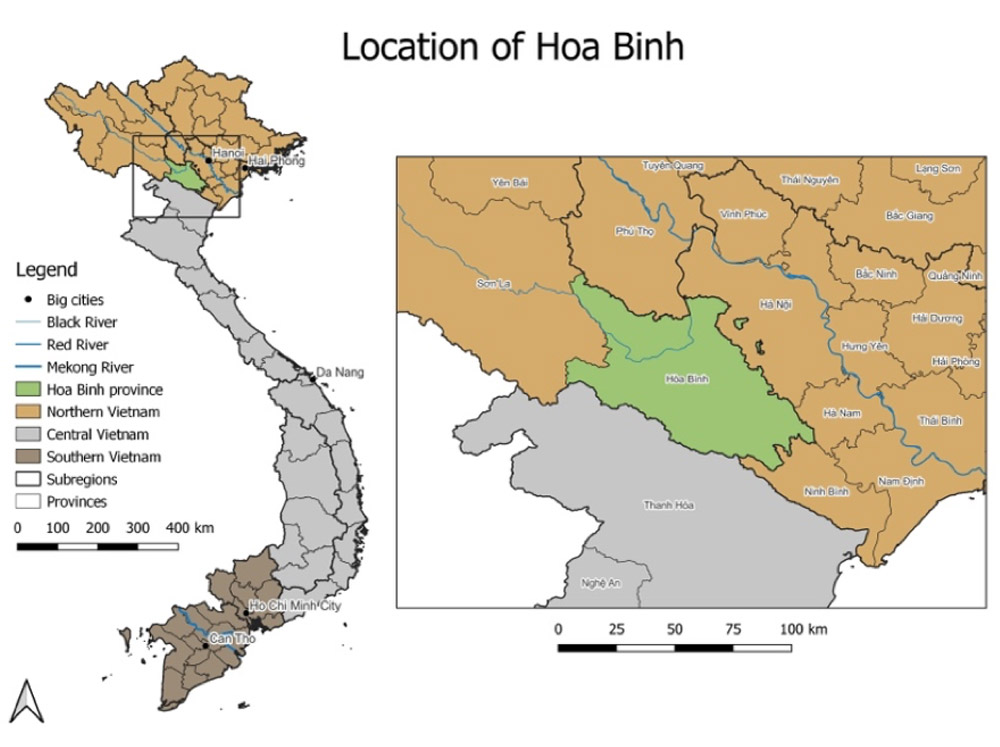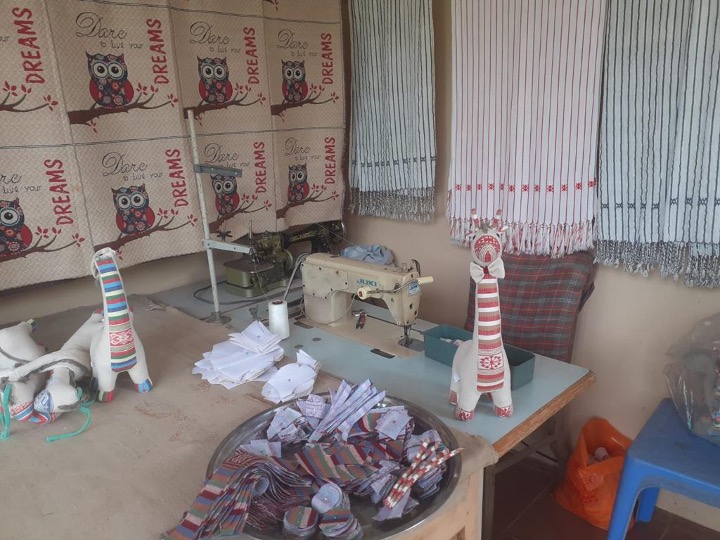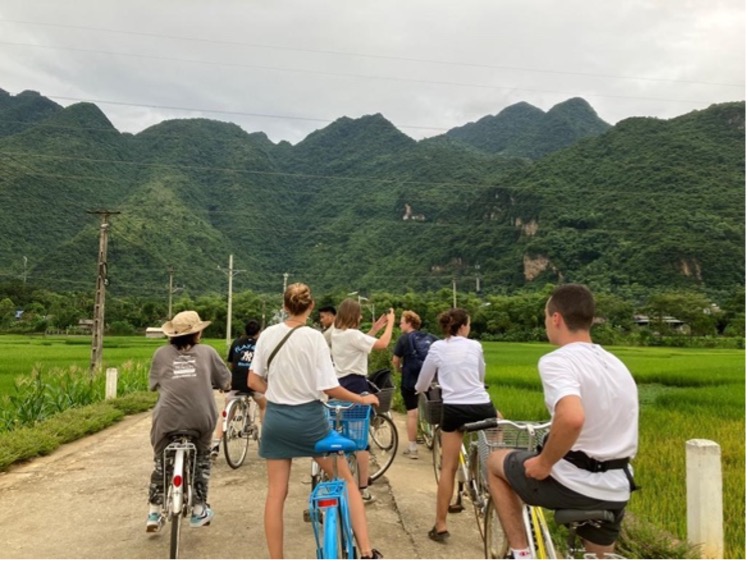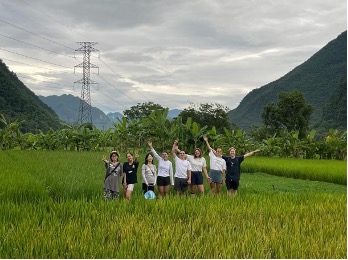Turning Theory into Action
By Joris Kolsters, An-Sophie Hons, Femke De Blende, Xiaoyang Chen, Lucie Verstraeten, Sylvain Guichard
What is theory if it is not put into practice? It is one thing to learn about the principles of sustainable development in a classroom, but it is quite another to venture into Vietnam and to confront these theories with reality. In the previous year of the master’s, we strengthened our knowledge during classes, delving deep into the various facets of sustainable development and the various debates surrounding the role of tourism in achieving sustainable goals. However, we knew that to fully understand, appreciate, and verify these concepts, a real-world experience was needed.
After extensive preparations, including preliminary mapping, literature reviews, and the making of a survey, the foundation of our research was all set. It was time to go to our destination in the communes of Mai Chau and Da Bac in the province of Hòa Bình, in Northern Vietnam. Our goal was to collect data on tourism’s effects on livelihoods and the environment in the region. Most specifically, our group, the mapping group, was interested in the spatial patterns of tourism development and the various impacts it has on the livelihood and employment of local communities involved in tourism activities.
Our journey began with a blend of excitement and uncertainty. As we stood in front of the homestay where we would end spending most of the evenings of the living lab, we were surrounded by the unfamiliar and welcoming landscapes of Mai Chau and Da Bac. We realized that this was the moment we were waiting for. Being physically present in the study areas enhanced not only the quality of the interviews but also the mapping process by providing direct observations. This firsthand experience enabled a more precise and comprehensive mapping, incorporating subtle details, local context, and dynamic changes that might be missed when assessing the area remotely. This is especially relevant when studying tourism development, in relation to sustainability, where perspectives between scholars often differ. The opportunity to contribute to this debate by highlighted the characteristics of tourism development in the context of rural Vietnam was a driver for each researcher of the group.
To be able to understand and map tourism infrastructures in the province of Hòa Bình, we went to the different tourism facilities of the area by bike, ranging from luxury resorts to homestays to handicraft shops. As we ventured through the roads, our group felt a sense of eagerness, knowing that each turn could reveal something new and valuable for our research. Our personal experiences intertwined with the academic pursuit, which was new and exciting. To collect the data, we divided our daily groups into two or three subgroups who went around the research areas to interview the owners of these tourism facilities. To keep the interviews structured, we used a survey that we had written in Leuven, if interesting things came along, we would ask some follow-up questions and make notes of that as well. For example, an extra question regarding environmental damage was added, as most of the respondents would mention this topic on their own.
One of our first observations was the presence of handicrafts in almost all homestays. Thus, we would like to elaborate on the role of handicraft in shaping the impacts of tourism on people’s livelihood and employment. As shown in the picture below, handicrafts are a central part of the tourism industry in the region. These can range from traditional clothing and accessories to food and cosmetic products. The particularity of these handicrafts is that they support community-based tourism (CBT), whereby people from the same village gather resources and skills to create unique products, which, when sold, bring financial support to the whole community. In this sense, we quickly realized that tourism business in the area created both direct and indirect employment opportunity. In addition, they make great souvenirs to bring back with us, and they were highly appreciated by our friends and family!
After a full day of data collection, our group always came together to gather and store all the data in our Excel sheet to have a digital backup of our data as well. This Excel sheet is also crucial as it can be used for GIS purposes. QGIS helped us to visualize our raw data into patterns which allowed us to make informed decisions for the days ahead. Our evenings were often spent reflecting on the day’s discoveries, surrounded by the vibrant culture of Vietnam. Whether we were marveling at the intricacies of handmade crafts or savoring local delicacies, our personal experiences became integral to the fabric of our academic journey.
Expect the unexpected
The moment we arrived, we realized that reality often diverges from our preconceived expectations, and that is all part of the learning process. Sometimes, our preparations did not align with the actual conditions in the field, which was the case for our survey. After our first day of fieldwork and conducting the surveys, we found that some questions were not as suitable as we thought. This resulted in the fact that our group had to hand-correct and rewrite our already printed surveys. The corrections and adjustments mirrored the dynamic nature of our research, reminding us that flexibility is key when translating theory into action. We were the first master group that travelled to Vietnam for field work. This also means that from the start on, we did not really know what to expect. However, our research and our challenges will be a foundation for future groups. In our living lab reports we will therefore highlight the challenges we come across to help future groups to overcome these challenges.
For example, we discovered that there were fewer tourism facilities in the area than indicated on Google Maps, which led us to increase the size of the study area. As you may have understood already, it was quite a leg work out! This Living Lab highlighted the importance of adaptation. There is room to make mistakes if they can contribute to the broader learning process. On the following picture, you can see our group in the middle of an exploration stage in which we found homestays that were not present on Google maps.
Navigating the unexpected twists and turns in the Vietnamese countryside became a metaphor for our academic journey. Throughout the living lab, we could feel that we gained more and more experience and were able to extend our skillsets as well. Also, as we collected more data, we were able to uncover patterns and links that were not evident before and allowed us to narrow down in our research. Another positive thing that we did not expect beforehand was the willingness of our respondents to assist us with our research. We had some prior experience doing interviews and surveys and often people are not very willing to participate. However, in the Hòa Bình area, most people were happy to participate and did not mind when sometimes it would take a little bit more time. While the availability of tourism facilities was less than expected, the response rate was higher than anticipated. Sometimes the interview would transform into a nice conversation accompanied by a warm cup of tea, and that was lovely.
Collaboration with other groups
Unsurprisingly, the language was often a barrier; in most cases, the respondents did not speak English. Luckily, this living lab had a partnership with Vietnam National University students and professors, who not only assisted us in translating but also shared their invaluable insights and expert perspectives on the subjects we were investigating.
As we conducted fieldwork, we gathered data not just for our research but also for other groups, even though this subject fell out of the scope of your expertise. This, however, also meant that other groups would collect data for us as well. There was always someone from our main group present, who would supervise and lead the other people in his or her respective groups. Of course, you cannot supervise everyone the whole time, that is why it was incredibly important to brief everyone as clearly as possible beforehand. While the rotation of the teams sounded complicated at first, it was the opposite. First of all, people who operate in a different area of expertise or in a similar area can help to shine new light on your research which can lead to new findings. Secondly, the group rotation was useful to put the multidisciplinary aspect of the master into practice. In a broad sense, the rotation helped to construct the bridge between social and ecological sciences, which is also a key aspect of the whole master’s in general.
Personal Growth
Working in a foreign country, closely collaborating within a team, and researching a new area offered us enriching experiences. We had the opportunity to visit places we would not have otherwise and engage with locals in ways we normally would not. We got to see Vietnam in a unique way, gained experience about the “backstage of tourism” and learned about and from the local people and culture. The Living Lab was more than an academic experience; it was a deeply personal journey that allowed us to connect not only with our team but also with the natural beauty and people of the region.
But of course, we were the first master group that travelled to Vietnam for field work. This also means that from the start on, we did not really know what to expect. However, our research and our challenges will be a foundation for future groups. In our living lab reports we will therefore highlight the challenges we come across to help future groups to overcome these challenges.
As we mentioned at the start of this blog post, the Living Lab was an unforgettable experience that left a lasting impact on both our academic and personal lives!



